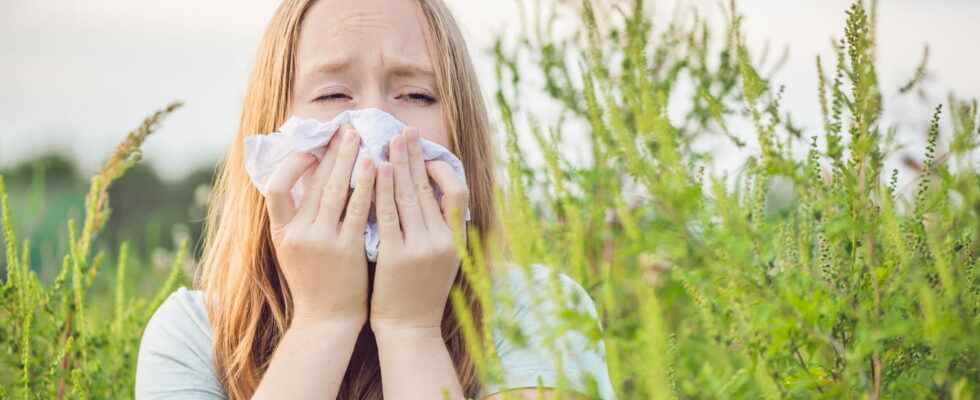Watch out for grass pollen! The risk of allergy linked to these pollens is high at the moment and until at least the end of June. Map, symptoms and anti-grass pollen treatments with Pr Christophe Dupont, allergist.
[Mise à jour le 20 juin 2022 à 14h57] The risk of allergy is high throughout the country and will remain so for several weeks with hot and sunny weather conditions very favorable to the emission and dispersion of high concentrations of grass pollen in the air, inform him RNSA June 17. The risk of allergy linked to these pollens is high and will remain so for several more days before decreasing towards the end of June. Prevention advice, symptoms, period and risk map.
Definition: what are grasses?
“The grasses are flowering herbaceous plants of the Poaceae family, historically classified in the Gramineae family, answers Pr Christophe Dupont, allergist. These are cereals, reedsthem bamboosthem prairie grasses natural and the lawns cultivated, like grass“.
What is the situation of grasses in France in 2022?
Grasses are usually present in springin March and April or of may to july depending on the pollens present at these times and the grasses that grow at these times. The risk of allergy is high throughout the country and will remain so for several weeks with hot and sunny weather conditions very favorable to the emission and dispersion of high concentrations of grass pollen in the air, informs the RNSA on June 15. The risk of allergy linked to these pollens is high and will remain so for several more days before decreasing towards the end of June.
What are the symptoms of a grass allergy?
Grass pollen allergy causes a series of well-identified symptoms:
- sneezing often iterative and described as “burst”;
- stuffy nose, called obstructive rhinitis or runny nose, called rhinorrhea.
- an itchy nose;
- inflammation of the lining of the nose;
- a conjunctivitisi.e. inflammation of the eyes;
- headaches ;
- a inflammation of the pharynx with itching sensation.
In the presence of these allergens, the immune system of the allergic person will react by releasing histamine, a variety of hormone which will be at the origin of the inflammation, predominant in the nose. If the allergy is important, it is possible that it leads to serious manifestations such as asthma.
When and who to consult for a grass allergy?
The doctor or allergist at the first symptoms. The diagnosis of a grass allergy is based on the anamnesis, a medical term designating the interrogation of the patient and the research of family or personal antecedents of allergies. There are also skin tests (or prick-tests) which make it possible to highlight the allergens involved. They are particularly reactive in patients between the ages of 15 and 25.
How to relieve grass allergy?
The treatment of grass pollen allergy consists first of all of doing what you can to avoid coming into contact with the allergen (a difficult situation with grass pollen allergy). Many tips can help reduce these contacts and live better with pollen. In addition, the symptoms of a grass pollen allergy are treated with:
- antihistamine drugs;
- Local treatments can be applied in the nose, eyes or bronchi.
You can also perform a desensitization to gradually accustom the body to the grass allergen. Treatments are mainly carried out in the form of drops which is deposited every morning under the tongue and left to melt for 2 minutes. Treatments in tablet form are also available for those with allergies. Desensitization in injectable form (increasing doses of a solution containing the substance identified as allergenic is injected under the skin) is used less and less.
What are the cross allergies with grasses?
“There may be a cross-allergy between grass pollen and certain foodswhen these plants are closely related and share antigenic patterns (which means that small protein parts of these foods are identical to those of grass pollens), continues the specialist. These foods are, non-exclusively, wheat flour (which is also a grass), tomato, pea, melon, orange, potato, peach, kiwi, celery and pepper… This cross-allergy is responsible for a so-called “oral” syndrome, which is characterized by tingling of the mouth and pharynx when the patient consumes the raw food. These manifestations disappear if the food is cooked “.
Prevention: how to reduce your exposure to grasses?
Some helpful tips can help limit grass allergy. You have to make sure toavoid the allergen. If it is not possible to stay cloistered at home, it is however preferable not to open the windows when there is wind (which carries pollen). Same thing in the car when driving in the countryside.
Thanks to Pr Christophe Dupont, allergist at Clinique Marcel Sembat.
